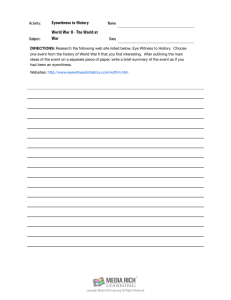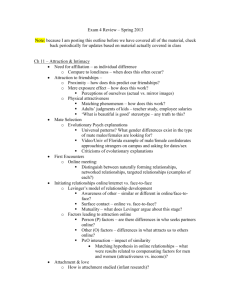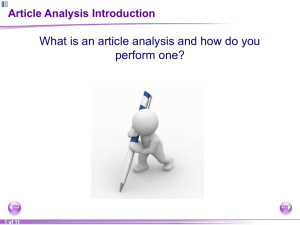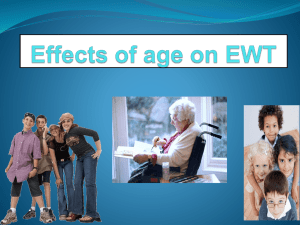Theories of Human Development
advertisement
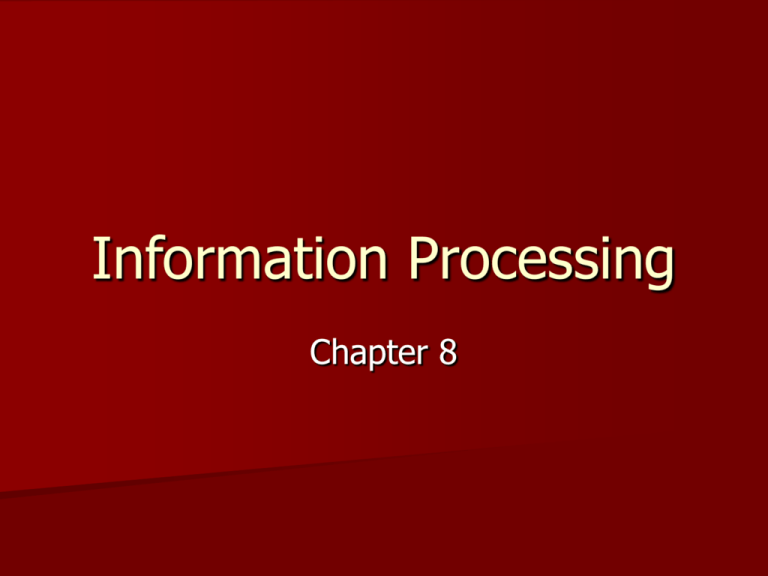
Information Processing Chapter 8 Information Processing Approach Goal = examine how children/adults operate on/process information Have limited capacities No single theory General approach Reasoning processing abilities More efficient processing = better reasoning Focus on domain specific skills rather than general skills that apply across domains Models of Information Processing Atkinson & Shiffrin’s multistore model – Three parts of system Sensory register Short term memory (STM) (book = short term store) Long term memory (LTM) (book = long term store) – Inborn and universal – Analogy = computer Stores = hardware Control processes/mental strategies = software Atkinson & Shiffrin’s Model Sensory Register – Sights/sounds represented directly – Limited capacity Short-Term Memory (STM) – Conscious part – Limited capacity 7 +/- 2 units of information – Limited time Atkinson & Shiffrin’s Model Long-Term Memory (LTM) – Unlimited capacity – Unlimited time frame – Organization and memory strategies • Figure 8.1 A schematic model of the human information processing system. ADAPTED FROM ATKINSON & SHIFFRIN, 1968. Levels-of-Processing Model No “containers” with fixed limits Retention depth Levels-of-Processing Model Queen Bread West Boy Cold East Play Butter Thin Table Girl North Chair Love King Lake Hat Pencil Hot Lamp Bottle Candy Photograph Belt Levels-of-Processing Model Shallow decays Deeper retained Problems due to distribution of attention Levels-of-Processing Model STM/STS replaced by working memory – The conscious pool of attentional resources from which our information-processing activities draw (Baddeley, 1992) Attention depends on learned/automatic processes Operating efficiency hypothesis – Case Comparisons Hardware and software change Levels-of-processing software Control processes improve with age Controversy regarding hardware… Control Processes (Software/Strategies) Strategy = deliberately implemented, goal-directed operations used to improve task performance Increase likelihood information in STM to LTM In general, younger children = fewer strategies; less effective Control Processes (Software/Strategies) Production deficiency Utilization deficiency Control Processes (Software/Strategies) Children of all ages have a variety of strategies that they choose from when solving problems – not stagelike Rehearsal – Rarely < 6-7 years Control Processes (Software/Strategies) Organization Elaboration – Develops late, compared to other strategies Retrieval of Information Recognition Recall – Free recall vs. cued recall Reconstruction Fuzzy-Trace Theory Continuum of memory representations – Verbatim = literal – Fuzzy (gist) = content, but not detail Capacity vs. Knowledge Why is the memory of older children/adults better than that of younger children? Capacity Knowledge Capacity vs. Knowledge Differences in children’s and adults’ memory knowledge Chi: children and adults tested on memory for chess pieces – – – – – Chess position presented for 10 seconds Immediate recall – place pieces on blank board Repeated recall – keep going until perfect 4 lists of 10 digits were also presented Children chess experts, adults novices Capacity vs. Knowledge Chi: Results – Interaction between age and material Children outperform adults when they’re more knowledgeable Capacity vs. Knowledge Children in Chi’s study were 9 years old, what about younger children? Problem: children’s knowledge may improve performance, but to measure STM capacity, need a test not influenced by differences in knowledge Attentional Processing Control – Focused and sustained – Infants and preschoolers were seated at a table with age-appropriate toys Concentrated involvement Attentional Processing Patterns of Attention – Young infants habituation – Preschoolers – 5-6 year olds Adaptability Attentional Processing Patricia Miller: strategy development follows a predictable sequence – Production deficiency – Control deficiency – Utilization deficiency Planfulness Thinking out a sequence of acts ahead of time and allocating attention accordingly to reach a goal Infancy Preschool Memory Infantile amnesia – Nonverbal form – Sense of self Development of Scripted Memory Scripts – schemes for recurring events organized in terms of causal and temporal sequences – Organizes world – Tend to remember info consistent with scripts – Become more elaborate with age Eyewitness Memory Attorney: “How did you get hurt at naptime?” Child: “I don’t know.” Attorney: “Did Sandy hurt you?” Child: nodded yes Eyewitness Memory Older children > younger children Preschooler accurate, fewer precise details False memories are as resistant to forgetting as true memories are Eyewitness Memory Leading questions suggest answers Even adults are susceptible – Loftus – film of car crash Age-related changes in susceptibility to misleading questions Eyewitness Memory Ages 3-12 told story with pictures Some information presented both verbally and in pictures, some information in pictures only Story about a girl on the first day of school who ate her breakfast too quickly and got a stomachache Stomachache verbally and in pictures, eggs in picture only Eyewitness Memory Results (% correct) 3-4 5-6 7-9 10-12 Control: 84 87 95 95 Biased: 37 58 67 84 Eyewitness Memory Perhaps no memory distortion Children are intimidated by authority? 4 and 5 year olds given same task, but 7 year olds did interview second day Eyewitness Memory Results biased: 53% correct unbiased: 72% correct Selected children from experiment 1 who fell in 4-5 year old range biased: 34% correct unbiased: 74% correct Eyewitness Memory Misleading suggestions memory errors Children, especially young children, may be most susceptible, but it’s not clear why Children younger than 9/10 are far more susceptible than older children, adolescents, and adults Memory for Actual Events 4 and 7 year olds went to a trailer where an adult interacted with them and played games – Simon says – Clown 10-12 days later returned for a memory test – Specific questions – Misleading questions Memory for Actual Events Results Specific questions: 4-year-olds 79% 7-year-olds 91% Misleading questions: 4-year-olds 86% 7-year-olds 95% correct correct correct correct Memory for Actual Events Memory of a medical examination Memory: – Free recall – Anatomically detailed doll – Direct and misleading questions Memory for Actual Events Results – Genital condition – Nongenital condition – 3 out of 36 falsely reported in response to misleading questions False reports rare, but did occur Memory for Actual Events Children may underreport abuse Be careful of leading questions
